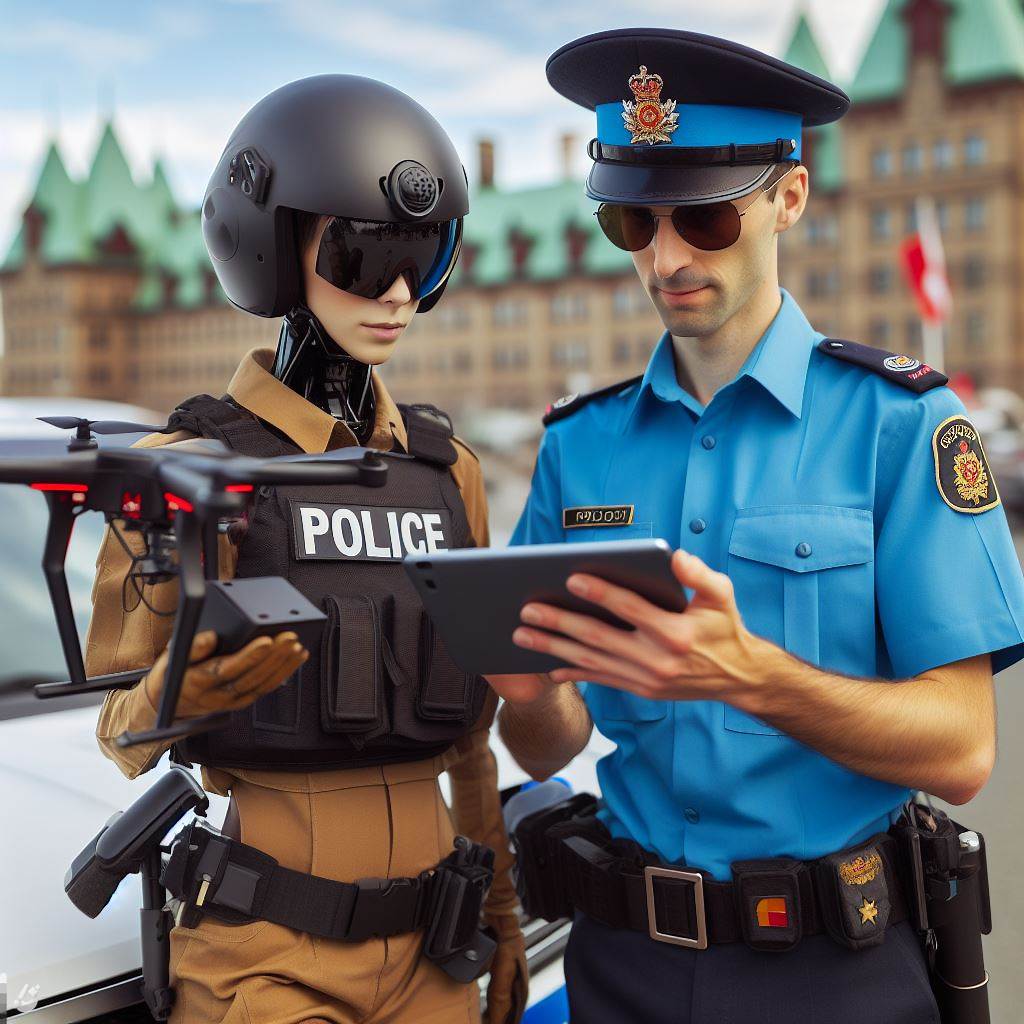Introduction
Modern policing is heavily reliant on technology, which plays a crucial role in enhancing law enforcement.
The relationship between modern policing and technology is pivotal for effective and efficient law enforcement.
Technology has become increasingly important in optimizing law enforcement strategies and overcoming challenges.
The importance of technology in modern policing cannot be overstated, as it significantly improves overall effectiveness.
Technology enables law enforcement agencies to gather and analyze large amounts of data efficiently.
With advanced technology, policing agencies can monitor and respond to incidents swiftly, increasing public safety.
Technological advancements have revolutionized crime prevention and detection through tools like surveillance cameras and facial recognition.
Increased access to information and real-time data empowers police forces to make informed decisions promptly.
The ability to communicate seamlessly and securely, thanks to technology, enhances collaboration among law enforcement agencies.
Efficient use of technology in modern policing allows for better resource allocation and more targeted crime prevention strategies.
Advanced technology, such as drones and body cameras, equips police officers with the tools to ensure transparency and accountability.
In summary, technology plays a vital role in modern policing, improving effectiveness and efficiency in law enforcement efforts.
The Evolution of Technology in Policing
The use of technology in policing has come a long way, transforming the methods and effectiveness of law enforcement agencies across the globe.
From basic tools to modern advancements, the progression of technology in policing showcases a remarkable journey of innovation and improvement.
Here, we will delve into the historical development, highlight key examples, and explore the revolutionary impact of technology on crime prevention.
Historical Progression of Technology in Policing
- Early policing relied on rudimentary tools such as whistles and wooden truncheons as means of communication and defense.
- The introduction of police radios during the early 20th century vastly improved communication and response time.
- Automobiles revolutionized policing in the mid-20th century, enabling rapid mobility and efficient patrolling.
- The advent of forensics technologies such as fingerprinting and DNA analysis provided powerful investigative tools.
Each phase of technological advancement brought new possibilities and capabilities to law enforcement agencies, exponentially enhancing their ability to combat crime effectively.
Examples of Technological Advancements in Policing
- Police radios: Enabled instant communication between officers, significantly improving coordination and response time.
- Patrol cars: With the introduction of automobiles, officers gained the ability to cover larger areas and respond swiftly to emergencies.
- CCTV cameras: Surveillance systems expanded monitoring capabilities, facilitating identification and evidence gathering.
- Forensic technologies: Tools like fingerprint analysis and DNA profiling vastly improved investigative accuracy and efficiency.
These examples, among many others, have become integral to modern policing practices, enhancing both officer safety and crime-solving capabilities.
Revolutionizing Policing Methods and Crime Prevention
Technology has not only brought advancements to policing tools but has also revolutionized the very methods employed by law enforcement agencies.
The use of data analytics and predictive policing algorithms now allows police departments to anticipate crime hotspots and allocate resources accordingly, preventing crimes before they occur.
GPS tracking systems have enhanced officer safety by enabling real-time monitoring of their locations, ensuring quick response and assistance when needed. This technology has been particularly beneficial in high-risk situations.
Body-worn cameras have become an essential tool for accountability, ensuring transparency during interactions between officers and civilians and serving as valuable evidence in legal proceedings.
Furthermore, social media monitoring and digital forensics have equipped investigators with powerful tools for gathering intelligence and evidence in the increasingly digital world.
The advent of technology has undeniably propelled policing into a new era of efficiency, effectiveness, and proactive crime prevention.
The evolution of technology in policing has been an incredible journey, with each advancement propelling law enforcement agencies to greater heights of effectiveness.
From the humble beginnings of whistles and truncheons to the sophisticated tools of today, technology has transformed not only the tools used by police officers but also their methods of crime prevention.
Unlock Your Career Potential
Visualize a clear path to success with our tailored Career Consulting service. Personalized insights in just 1-3 days.
Get StartedWith continued innovation, the future of policing holds great promise, ensuring safer communities and a better world for all.
Read: Public Servants’ Role in Policy Making
Current Technological Innovations in Policing
Exploring the Latest Technologies
- Body cameras, drones, and predictive analytics are among the latest technologies used by police forces.
- These technologies have revolutionized the way evidence is collected in law enforcement.
- Body cameras provide video evidence, offering transparency and accountability in police encounters.
- Drones enable aerial surveillance, allowing law enforcement to gather intelligence and assess situations efficiently.
- Predictive analytics utilize data to forecast crime patterns, aiding in proactive policing strategies.
Assisting in Collecting Evidence and Enhancing Officer Safety
Technological advancements in policing play a crucial role in evidence collection and officer safety.
- Body cameras have a significant impact on gathering evidence, providing a visual and audio record of interactions.
- These cameras have proven invaluable in increasing transparency and accountability.
- Officers wearing body cameras are often aware that their actions are being recorded, promoting professionalism.
- Drones with high-resolution cameras assist in capturing aerial footage for surveillance and evidence gathering.
- Utilizing drones for surveillance reduces the risks officers may face in dangerous or high-risk situations.
Combatting Crime with Technological Advancements
The implementation of advanced technologies has significantly improved law enforcement’s ability to combat crime.
- The use of predictive analytics allows police departments to allocate resources more effectively.
- By analyzing historical data, predictive analytics can identify crime hotspots and predict potential criminal activities.
- This proactive approach enables law enforcement to deploy officers to targeted areas, preventing crimes before they occur.
- Moreover, real-time data provided by these technologies aids in rapid response and more efficient investigations.
- Technological innovations have bridged gaps in communication and information sharing among different agencies.
Challenges and Ethical Considerations
While technology in policing brings numerous benefits, it also raises certain challenges and ethical concerns.
- Privacy concerns arise with the widespread use of body cameras and surveillance drones.
- Recording every interaction compromises the privacy rights of individuals, requiring careful policies and regulations.
- The storage and management of massive amounts of data collected by these technologies pose logistical challenges.
- Ensuring data security and preventing unauthorized access to sensitive information is imperative.
- Moreover, the biased use of predictive analytics algorithms may lead to over-policing in certain communities.
- It is vital to address these ethical considerations and ensure technology is used in a fair and unbiased manner.
Overall, the use of technology in modern policing has transformed law enforcement practices.
From enhancing evidence collection and officer safety to combating crime more effectively, these technological advancements have proven invaluable.
However, it is crucial to navigate the challenges and ethical concerns carefully, ensuring that technology is used responsibly and with proper oversight.
Read: The Impact of AI on Policy Analysis
The Impact of Technology on Crime Prevention
Technology has had a profound impact on various aspects of our lives, including how law enforcement agencies combat crime.
In this section, we will delve into the role of technology in deterring and preventing crimes, the effectiveness of surveillance systems, facial recognition software, and data analysis in identifying criminals, and the potential benefits and drawbacks of using artificial intelligence in law enforcement.
Role of Technology in Deterring and Preventing Crimes
- Technology acts as a deterrent by increasing the chances of criminals getting caught.
- The presence of surveillance cameras and other technological measures creates a sense of vigilance.
- High-tech alarm systems can prompt immediate responses from law enforcement, preventing crimes in progress.
- GPS tracking devices can aid in recovering stolen property, discouraging theft in the first place.
- Mobile and internet-based crime reporting systems make it easier for citizens to report suspicious activities.
Effectiveness of Surveillance Systems, Facial Recognition Software, and Data Analysis
- Surveillance systems provide real-time monitoring and video evidence, aiding in identifying criminals.
- Facial recognition software analyzes facial features, matching them against criminal databases.
- This technology helps law enforcement agencies identify suspects and monitor their movements.
- Data analysis tools mine large databases and identify patterns that may help prevent criminal activities.
- By analyzing data, law enforcement can deploy resources more efficiently and target high-crime areas.
Potential Benefits and Drawbacks of Using Artificial Intelligence
- Artificial intelligence (AI) can analyze vast amounts of data quickly, saving time for investigators.
- AI-powered algorithms can identify trends and predict crime hotspots, helping allocate resources effectively.
- Facial recognition powered by AI can rapidly identify suspects even in crowded and chaotic environments.
- Despite the benefits, there are concerns about AI bias and potential infringements on privacy rights.
- Unauthorized access to databases can compromise the integrity of AI systems and lead to false identifications.
Technology has significantly enhanced crime prevention methods by deterring criminals, aiding in identifying suspects through surveillance systems and facial recognition software, and enabling data analysis for more effective resource allocation.
As technologies continue to advance, it is crucial to carefully navigate the potential drawbacks, ensuring the protection of civil liberties and privacy rights.
By harnessing the power of technology responsibly, law enforcement can continue to stay one step ahead in the battle against crime.
Read: Policy Analysts: Skills and Qualifications
Improving Police-Community Relations
Addressing the gap between law enforcement and the community is a critical aspect of modern policing.
Technology plays a significant role in bridging this gap and strengthening relationships between police and the public.
Technology as a Bridge
It serves as a bridge between law enforcement and the community by enhancing communication and collaboration.
- Police departments can utilize social media platforms to engage with the public actively and disseminate important information.
- By leveraging community-focused applications, law enforcement agencies can create platforms that provide a space for residents to voice concerns, ask questions, and share information.
- Mobile applications enable citizens to report crimes, suspicious activities, or emergencies directly to the police, enhancing the efficiency of the law enforcement response.
Community-Focused Applications of Technology
Technology offers various community-focused applications, augmenting police-community relations.
- Social media engagement allows police departments to establish direct lines of communication with the public, fostering trust and transparency.
- Community platforms serve as virtual meeting places where residents and law enforcement can come together to discuss local issues, propose solutions, and build relationships.
- Mobile applications offer features like crime mapping, providing citizens with timely information about criminal activity in their neighborhoods, empowering them to make informed decisions.
Technology and Promoting Transparency, Accountability, and Trust
It enhances transparency and accountability within law enforcement, thereby building trust with the public.
- Body cameras worn by police officers provide an objective record of interactions, increasing transparency and ensuring accountability.
- Dashboard cameras offer additional visual evidence, boosting public trust in the actions of law enforcement officers.
- Data analytics can assist police departments in identifying patterns and trends, enabling targeted and proactive crime prevention strategies.
- Online portals can give the public access to information like crime statistics, budget allocations, and officer training, promoting trust by increasing transparency.
In short, technology plays a vital role in improving police-community relations by facilitating communication, fostering transparency, and creating opportunities for collaboration and trust-building between law enforcement and the public.
Embracing technology-driven solutions can bridge the gap and create safer and more cohesive communities.
Read: A Day in the Life of a Policy Analyst

Challenges and Concerns of Technological Advancements
- As technology shapes modern policing, drawbacks and limitations arise from overreliance.
- Data privacy is a major concern, demanding safeguards to protect individuals’ privacy rights.
- Biases in algorithms pose a risk, requiring transparency, fairness, and regular audits for prevention.
- Misuse or overreliance on technology can undermine law enforcement efforts, emphasizing the need for human judgement.
- Addressing challenges necessitates regulations, training, and oversight.
- Policymakers must collaborate for guidelines on responsible technology use, including data handling and transparency in algorithms.
- Training programs should equip officers with technology skills and ethical considerations awareness.
- Oversight by independent bodies is crucial for monitoring and ensuring adherence to regulations and ethical standards.
- Regular audits and evaluations are essential to identify and rectify issues related to privacy, biases, or misuse.
Basically, embracing technology in policing requires proactive measures to mitigate challenges and ensure responsible, ethical use.
Learn More: Ethics and Conduct in Public Service
Conclusion
- Technology plays a crucial role in transforming modern policing, enhancing public safety and crime prevention.
- Surveillance systems, predictive tools, and forensic advancements contribute to technological progress in law enforcement.
- Real-time monitoring, quick response times, and data analysis enable agencies to stay ahead of criminals.
- A balanced approach is crucial, combining technology with human judgment and ethical considerations.
- The human element is essential for critical decision-making and ensuring justice in law enforcement.
- The future holds potential with advancements like artificial intelligence and robotics reshaping policing.
- Policymakers and society must stay vigilant to ensure responsible and ethical technology use.
- Reflecting on technology’s impact raises moral questions about ethical use and prevention of misuse.
- Striving for a balanced approach, we aim to create a safer and more just society with technology and human values.
In closing, embracing technology in policing requires a thoughtful balance, acknowledging its benefits while upholding ethical considerations and human values.




